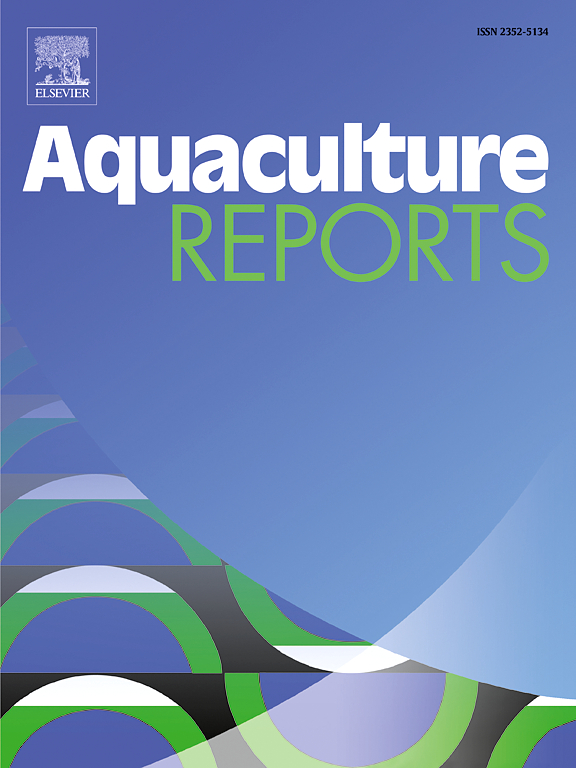饲料蛋白质/脂肪比对狭蛏幼鱼生长性能和叶酸介导的单碳代谢有影响
IF 3.7
2区 农林科学
Q1 FISHERIES
引用次数: 0
摘要
目前对双壳类动物的人工饲料、营养需求和代谢的研究非常有限。本试验研究了不同饲粮蛋白/脂比对缢蛏幼鱼生长和叶酸代谢的影响。配制4种不同蛋白质(27-48 %)和脂肪(2 - 14 %)水平的微胶囊饲料,分别为P48L2(48 %蛋白质和2 %脂肪)、P41L6、P34L10和P27L14组。蛤的初始壳长为2.7 ± 0.08 mm,饲喂14 d。结果表明,对虾幼虾适宜的饲料蛋白质/脂肪比为4.6。随着饲粮蛋白质/脂肪比的降低,蛤蜊的脂肪水平呈上升趋势,适当的蛋白质/脂肪比可提高淀粉酶、过氧化氢酶和超氧化物歧化酶的活性。转录组分析表明,与P34L10和P27L14相比,P41L6饲料降低了蛤的嘧啶/嘌呤代谢和叶酸碳库。同时,与P34L10组相比,P41L6组蛤蚌5-甲基四氢叶酸和叶酸水平降低,l -蛋氨酸和s -腺苷蛋氨酸水平升高。本研究结果首次揭示了蛤蜊适宜的饲粮蛋白质/脂肪比为4.6。此外,高蛋白/低脂饮食可能会导致蛋氨酸循环中代谢物的异常积累,抑制叶酸代谢,最终导致嘌呤和嘧啶合成减少,从而抑制生长。本研究结果可为蛤蜊饲料配方及理解饲料营养摄入比例与叶酸介导的单碳代谢之间的关系提供必要的理论支持。本文章由计算机程序翻译,如有差异,请以英文原文为准。
Dietary protein/lipid ratio affects the growth performance and one-carbon metabolism mediated by folate in juvenile razor clam Sinonovacula constricta
The current research on artificial feed, nutritional requirements, and metabolism of bivalves is extremely limited. Here, we studied the effects of dietary protein/lipid ratios on the growth and folate metabolism of juvenile clam Sinonovacula constricta. Four microcapsule feeds were formulated with different protein (27–48 %) and lipid (2–14 %) levels, designated as follows: P48L2 (48 % protein and 2 % lipid), P41L6, P34L10, and P27L14 groups. Clams, initially measuring 2.7 ± 0.08 mm in shell length, were fed these diets for a period of 14 days. Results showed the optimal dietary protein/lipid ratio for juvenile clams was predicted to be 4.6. The lipid level of clam exhibited an upward trend as the dietary protein/lipid ratio decreased, and the appropriate protein/lipid ratio enhanced the activities of amylase, catalase, and superoxide dismutase. Transcriptome analysis showed that the pyrimidine/purine metabolism and one carbon pool by folate in the clam fed P41L6 diet was downregulated relative to those fed P34L10 and P27L14 diets. Meanwhile, compared with P34L10 group, the clam in the P41L6 group exhibited decreased levels of 5-methyltetrahydrofolate and folate, and increased levels of L-methionine and S-adenosylmethionine. Our results for the first time revealed that the optimal dietary protein/lipid ratio for clam was 4.6. Furthermore, the high-protein/low-lipid diet may inhibit growth by causing abnormal accumulation of metabolites in the methionine cycle and inhibiting the folate metabolism, ultimately resulting in reduced purine and pyrimidine synthesis. Our findings may provide indispensable theoretical support for formulating feeds of clam and understanding the relationship between dietary nutrient intake ratios and folate-mediated one-carbon metabolism.
求助全文
通过发布文献求助,成功后即可免费获取论文全文。
去求助
来源期刊

Aquaculture Reports
Agricultural and Biological Sciences-Animal Science and Zoology
CiteScore
5.90
自引率
8.10%
发文量
469
审稿时长
77 days
期刊介绍:
Aquaculture Reports will publish original research papers and reviews documenting outstanding science with a regional context and focus, answering the need for high quality information on novel species, systems and regions in emerging areas of aquaculture research and development, such as integrated multi-trophic aquaculture, urban aquaculture, ornamental, unfed aquaculture, offshore aquaculture and others. Papers having industry research as priority and encompassing product development research or current industry practice are encouraged.
 求助内容:
求助内容: 应助结果提醒方式:
应助结果提醒方式:


